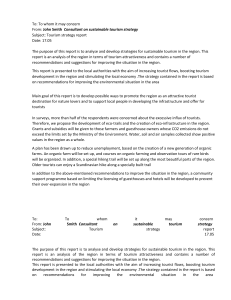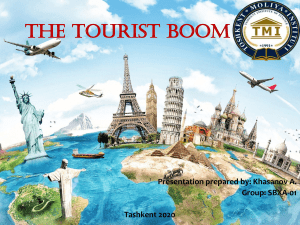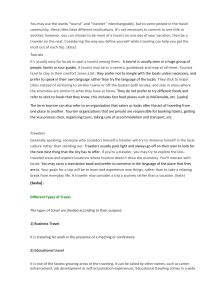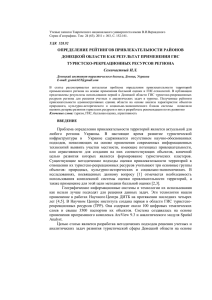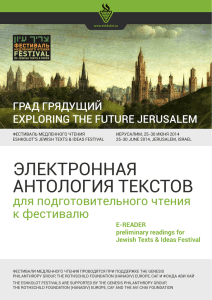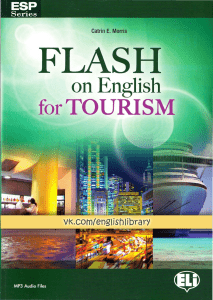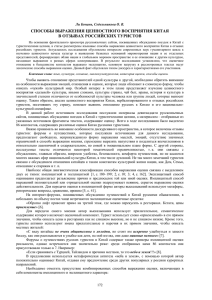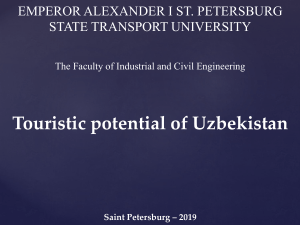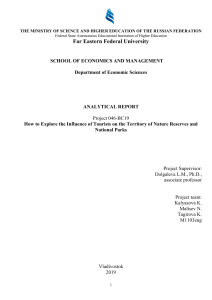Berger-ExploringReligiousTouristExperiencesInJerusalem(AM)
advertisement
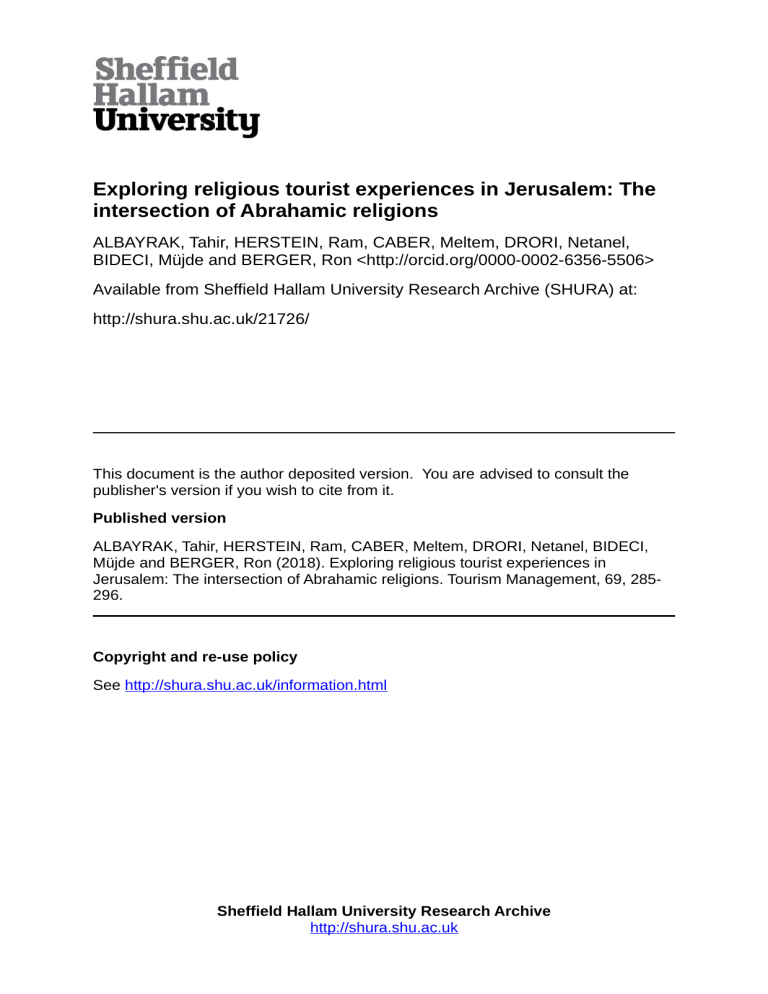
Exploring religious tourist experiences in Jerusalem: The intersection of Abrahamic religions ALBAYRAK, Tahir, HERSTEIN, Ram, CABER, Meltem, DRORI, Netanel, BIDECI, Müjde and BERGER, Ron <http://orcid.org/0000-0002-6356-5506> Available from Sheffield Hallam University Research Archive (SHURA) at: http://shura.shu.ac.uk/21726/ This document is the author deposited version. You are advised to consult the publisher's version if you wish to cite from it. Published version ALBAYRAK, Tahir, HERSTEIN, Ram, CABER, Meltem, DRORI, Netanel, BIDECI, Müjde and BERGER, Ron (2018). Exploring religious tourist experiences in Jerusalem: The intersection of Abrahamic religions. Tourism Management, 69, 285296. Copyright and re-use policy See http://shura.shu.ac.uk/information.html Sheffield Hallam University Research Archive http://shura.shu.ac.uk EXPLORING RELIGIOUS TOURIST EXPERIENCES IN JERUSALEM: THE INTERSECTION OF ABRAHAMIC RELIGIONS Abstract By considering the importance of religious tourism for travel and the tourism industry, this study aims to identify religious tourists’ experiences in Jerusalem, which is one of the most important holy destinations. In total, 848 data are collected from Jewish, Christian, and Muslim religious tourists visiting the site. Results show that religious tourism experience is a multifaceted construct, which consists of engaging mentally, discovering new things, interacting & belonging, connecting spiritually & emotionally, and relaxing & finding peace. By using such identified experience dimensions, tourists’ experience differences are clarified, depending on their religion. Findings also reveal that overall tourist satisfaction with Jerusalem is influenced by religious tourism experience. The study concludes by discussing the theoretical as well as managerial implications of the findings. Keywords: religious tourism; religious tourist experience; overall satisfaction, Jerusalem 1. Introduction As one of the earliest forms of tourism, religious travels still represent an important market segment in the tourism and travel industry. Especially for sacred sites, religious tourism offers a distinguished market position and destination image in a competitive marketplace. For spreading the social and economic benefits of religious tourism development, understanding the behavioral pattern of religious tourists is an important task for destination authorities. Many researchers admit that every market understanding starts with identifying tourist motivations and continues by discovering the experiences at the visited site (Vuuren & Slabbert, 2011; Weaver et al., 2009). Interestingly, despite the worldwide importance and popularity of religious tourism, researches that investigate the experiences of religious tourists are still scarce. In the literature, scholars commonly attempt to explore and to compare different type of traveler experiences, such as tourists and pilgrims (Bond & Parker, 2015; Nyaupane, Timothy, & Poudel, 2015). In addition, previous research suggests that religious tourists with different religions may have different behavioral patterns (Bailey & Sood, 1993; 1 Essoo & Dibb, 2004). However, to the best of the authors’ knowledge, to date, no research has compared the behavior of different religious tourists. Hence, the need for both the number of studies and the scientific perspectives in religious tourism literature to be expanded through additional research attempts. In light of the importance of religious tourism, and the lack of research about the experiences of religious tourists, this study aims to examine Jewish, Christian, and Muslim religious tourists’ experiences in Jerusalem through a survey. Jerusalem is selected as the field study site because it is a unique city, recognized by all Abrahamic religions. This historic city not only owns important holy places; it is also the global meeting point of religious tourists. Therefore, the findings of the study are expected to highlight comparative religious tourist experiences in a sacred site, and to contribute to the related literature. More broadly, the objectives of the study are: (1) to explore and to compare the demographic and trip-related characteristics of Jewish, Christian and Muslim religious tourists visiting Jerusalem, (2) to measure and to compare the religious tourism experiences, (3) to identify how the impact of religious tourism experience on overall satisfaction with the site may differ according to religion differences. The remaining parts of the paper are organized as follows. In the second section, a literature review about religious tourism is presented. In the third section, tourist experience and religious tourism experience are discussed from various perspectives used in other disciplines. Afterwards, the methodology of the research is introduced, and the obtained results are summarized. The paper concludes with a discussion of the findings, the main limitations of the study, and some recommendations for future studies. 2. Religious tourism Religious travel, which is the oldest form of tourism (Zamani & Eid, 2016) is a journey through spiritual locations for secular or religious reasons (Vuconic, 1996). While, in ancient times, travelers who visited holy places were mainly motivated by religious reasons (e.g. the quest to feel the divine power, to be healed, and to be blessed), in the modern era, travelers have evolved to become more secular. In other words, modern religious tourists travel for many other reasons (MacCannell, 1976; Oviedo, Courcier, & Farias, 2014). This is why; recently, many studies have been conducted to understand the underlying motivations of 2 religious tourists. For example, according to Griffin (2007) and Blackwell (2007), modern religious travelers are mostly motivated by the desire to learn new things and create spiritual memories in their lives, in addition to religious wishes and healing willingness. In general, most religious tourism research consists of case studies performed in various destinations, focusing on a particular religion. Hence, as stated by Bond et al. (2015), religious tourism literature mainly involves the identification and comparison of the experiences of different travelers (e.g. pilgrims and tourists) through collecting data from a destination. Whether focusing on different religions or destinations, the common discussion themes in the literature can be grouped under three headlines, namely: the conceptualization of religious tourism, the evolution of religious tourism, and the economic and cultural impacts of religious tourism. In the following paragraphs, each of these discussion themes is presented, respectively. Previous studies about the conceptualization of religious tourism attempt to define this phenomenon and to clarify its differentiating features from the other tourism types. A quick literature review, in this context, shows a debate about the overlapping use of the terms spiritual tourism, religious tourism, and pilgrimage tourism (Griffin, 2007). For example, the terms spiritual and religious tourism are used interchangeably by some researchers (e.g. Galzacorta et al., 2016). However, other researchers argue that these are distinct constructs, meaning different tourism types in terms of varying tourist motivations, visitor beliefs, and the most visited places (Kato & Progano, 2017; Heelas, 1998). In addition, researchers have documented the distinction between religious and pilgrimage tourism by identifying the participant characteristics. For example, as differing from pilgrimage tourists who must fulfil certain rituals in the sacred places, religious tourists might not have a religious belief at all (Galzacorta et al., 2016; Kujawa, 2017). Moreover, religious tourists may want to visit a destination for reasons of curiosity or admiration, while also benefiting from some supporting services offered in the area, such as tours and recreation activities (Bideci & Albayrak, 2016). Another debate about the conceptualization of religious tourism is related to the distinctions between pilgrims and tourists. Although Smith (1992) suggest that pilgrims and tourists should be positioned at the opposite ends of a spectrum (i.e. from sacred to secular), nowadays, most researchers agree that defining a clear distinction between these travelers is a difficult task (e.g. Ostrowski, 2000). While, a pilgrim, apart from his/her religious rituals, may also engage in non-spiritual activities (e.g. visiting touristic attractions and shopping), a 3 tourist can participate in spiritual activities whilst on holiday (e.g. visiting a holy place by taking a daily tour). This implies that, especially in the current post-secular world, “a tourist is half a pilgrim, if a pilgrim is half a tourist” (Turner & Turner, 1978, 20). Regarding the evolution of religious tourism, two major changing can be observed that have arisen, namely: the motivations of travelers, and the perceived essence of religious destinations (Heealas, 2006; Okamoto, 2015). For example, the people who visit religious sites often consist of secular travelers nowadays (Timothy & Olsen, 2006), in spite of the religiously motivated travelers of ancient eras (Nyaupane, Timothy, & Poudel, 2015). In other words, contemporary religious tourists may have various motivations, in addition to pilgrimage motives (Blackwell, 2007; Hyde & Harman, 2011). Another evolution in religious tourism involves the perceived essence of visited destinations. Although, certain religious locations are addressed in the medieval era as places of pilgrimage (Blackwell, 2007; CollinsKreiner, 2007), in the present, sites that are recognized as religious tourism destinations do not necessarily have the characteristics of a holy place or pilgrimage area. For example, the home of a famous person or his/her statue can become a spiritual place for people. According to Timothy and Conover (2006), rapid technological and social developments in people’s lives might lead to such types of evolutions in religious tourism. The exploration of the social and economic impact of religious tourism has been another area of discussion for the scholars. Many researchers admit that religious tourism, which represents a global market segment consisting of 330 million tourists (UNWTO, 2014), offers significant and positive economic impacts for visited sites (Amaro, Antunes, & Henriques, 2018; Kouchi, Nezhad, & Kiani, 2016). In addition, Rinschede (1992) states that religious tourism contributes to infrastructural developments, as well as increasing recruitment opportunities in host destinations. Especially in some countries, religious tourism constitutes an important part of the tourism industry. For example, in 2009, 44.5% of the export earnings of Indian tourism were from religious tourists’ spending (Bollaram, 2017). In contrast to its potential economic contributions, Vukonić (2002) points to the commercialization of religious services and sacred sites as a threat. The economic exchanges and social interactions between local people and religious tourists may lead to cultural transformations in host destinations (Joseph & Kavoori, 2001). For example, local religious rituals, which are performed by a small local group, may turn into international festivals (Shinde, 2007). However, such kinds of changes can be interpreted 4 differently by local people and tourists. From the local people’s perspective, such events may have negative impacts on cultural heritages, such as an increase in cultural degeneration. From the tourists’ perspective, unique local cultures enrich the value of destinations. For example, one of the most important religious events in northern Portugal, which is called ‘festa’, has made a significant contribution to the traditional and cultural identity of this destination (Fernandes, Melo, & Cardoso, 2016). 3. Tourist experience and studies on religious tourist experience Tourist experience is “a socially constructed term, whereby the meaning of the tourist experience is associated with multiple interpretations from social, environmental, and activity components of the overall experience” (Tussyadiah & Fesenmaier, 2009, 24). In a recent literature review, Adhikari and Bhattacharya (2016) categorize the antecedents, formation, and implications of customer experience into two main streams in the marketing field. While the first stream examines experience as a product attribute or a complete product, the second investigates experience through customer interactions with the physical environment or people. Hence, it would be logical to examine tourist experience research depending on these two streams and to present a review of studies conducted in the areas of economy, marketing, psychology, and sociology/anthropology (e.g. Walls et al., 2011; Sheng & Chen, 2013). In traditional economic transactions, customers may obtain products/services in an environment where businesses offer and filter experiences through expectations and mental images relating to the operator and other corresponding products/services (Komppula, 2006). However, as noted by Pine and Gilmore (2013), the nature of economic offerings being sold by companies has shifted in the age of post-modernity from products and goods to experiences. Holbrook et al. (1984) therefore proposed that the ‘world of products’ perspective should be changed into the ‘world of experience’ by putting a new emphasis on the customers’ role (Ritchie & Hudson, 2009). According to the customers’ point-of-view, “customizing a good turns into a service, customizing a service turns into an experience and customizing an experience turns into a transformation” in today’s experience economy (Pine and Gilmore, 2013, 14). Thus, in either real or virtual marketing places, companies need to offer transforming and authentic experiences to customers through impressive, theatre-like role performances. Moreover, post-modern tourists, like other consumers, became the “co- 5 producers who actively build their experiences through interactions with environment, suppliers and other tourists” (Walls et al., 2011, 20). In the marketing field, academics focus on the functional and technical aspects of service delivery (Otto & Ritchie, 1996; Huang et al., 2012) in order to clarify customer evaluations of service quality and satisfaction with an experience. Many researchers adapt the confirmationdisconfirmation theory, which compares customer expectations and evaluations, and uses Parasuraman, Zeithaml, and Berry’s (1994) ServQual model. However, recently, an increasing number of researchers have started to employ Pine and Gilmore’s (1998) fourdimensional experience model (i.e. escapist, educational, aesthetic, and entertainment), in which any of the experiences may fall into the active or passive fields of participation spectrums. Based upon Pine and Gilmore’s (1998) experience model, tourist experience can be accepted as a powerful driver of future behavioral intentions and a determinant of satisfaction (Kim, 2014). Accordingly, tourist satisfaction is defined as “an individual's cognitive-affective state derived from an experience” by Bosque and Martín (2008, 553). Hence, the post-hoc satisfaction approach has been popular in tourist experience research (Quinlan Cutler, 2015). In the psychology discipline, experiences are seen as subjective, personalized processes which are related to social cultures and varied systems (Larsen & Mossberg, 2007). The experience of a destination includes pre-trip preparation, post-visit remembering and the sharing of tripevents (Clawson & Knetsch, 1966). Thus, the psychological perspective states that “a tourist experience is a past personal travel-related event strong enough to have entered long-term memory” (Larsen, 2003, 15). Memories can be viewed passively as a store of experience, but can also be regarded as active re-enactments and guidelines for action (Selstad, 2007). Thus, Ryan (2010) notes that satisfactory and memorable tourist experiences should not simply be seen as a meeting of needs, but as an arising of wants and fantasies. This is because satisfactory experiences are stored in the form of stories and memories in tourists’ minds. Tourists, who create stories during their ‘authentic’ experiences later tend to share these stories with others as memories of their travels (Moscardo, 2010). In Tung and Ritchie’s (2011) qualitative study, the four dimensions of a memorable tourist experience were identified as: affect, expectations, consequentiality, and recollection. A recent literature review of Kim (2014) shows that destination attributes that potentially affect the creation of memorable tourist experiences are infrastructure, cost/value, accessibility, local culture, physiography and climate, entertainment, environment management, quality of service, 6 safety/security, hospitality, place attachment, superstructure, special events, and a mix of activities. From the sociological and anthropological perspective, experiences emerge from destinationtourist interactions, where destinations are the ‘theatres’ in which experiences take place, and tourists are the ‘actors’ playing the ‘tourist role’ (Stamboulis, 2003). Therefore, social group theory (Heywood, 1987) is adapted by researchers in order to test the relationships between tourists’ activity-based preferences and their social group characteristics. Role play approaches are also followed by some scholars, with the aim of exploring which tourists tend to play ‘a tourist role’. In addition, the theory of tourist gaze is employed in some studies (Urry, 1990), in which tourist gaze is considered as a travel experience which is different for each individual, since tourists subjectively objectify and interpret the places they visit (Tussyadiah & Fesenmaier, 2009). In religious tourism literature, a small number of studies exists about tourist experiences. In one such study, Andriotis (2009) attempted to explore male tourists’ experiences visiting Mount Athos, Greece by following a phenomenological approach. His results revealed the importance of spiritual, cultural, environmental, secular, and educational elements in the formation of authentic experience. In another study, Belhassen, Caton and Stewart (2008) proposed the term ‘theoplacity’ in their conceptual framework, which integrates previous approaches to authenticity. They further concluded that place, belief, action, and self, which are the sub components of theoplacity, generate an authentic pilgrimage experience. By using a phenomenological approach, Lopez (2013) conducted research on pilgrimage tourism experiences for the Way of St. James, examining 63 travel diaries that Italian pilgrims have published on the Internet. She offered a new concept, called ‘pilgrim 2.0’, to highlight the increasing importance of online communities for pilgrims. Recently, Bond, Packer and Ballantyne (2015) compared cathedral, shrine, and festival visitors’ experiences in the United Kingdom. The results suggested that the experience of ‘connecting spiritually & emotionally’ was the main determinant of beneficial outcomes for all types of visitors. In sum, there is still a lack of knowledge about religious tourism experience. 7 4. Methodology 4.1. Study site: Tourism in Jerusalem Jerusalem, one of the oldest cities in the world, is significant for a number of religious traditions, including the three Abrahamic religions, Judaism, Christianity, and Islam (Figure 1). Jerusalem was visited by 2.8 million tourists in 2016, mostly (61%) originating from the European continent. Tourists coming from the other continents were as follows: 27% America, 8% Asia, 2% Africa, and 2% Oceania. Breaking these figures down per country, 21% arrived from the USA, followed by Russia (13%), France (10%), Germany (6%), and Great Britain (6%). Relatively few tourists came from Islamic countries, such as Indonesia (22,000), Jordan (22,000), and Egypt (6,000) (CBS, 2017). Based on the Tourism to Jerusalem Statistical Report (2017), 36% of the tourists who visited the city were below 35 years old, 15% were between the ages of 35 and 44, 35% were between the ages of 45 and 64, and 14 % were 65 and over. These tourists were (mainly) hosted in more than 10,000 hotel rooms in Jerusalem. In terms of religion, 27% of the tourists were Jewish, 53% were Christian, 10% were Muslim and 10% had a different religion. In addition, 22% of the tourists asserted that they arrived for the purpose of pilgrimage. Figure 1 here* 4.2. Measures Survey items measuring religious tourism experience were adapted from Bond, Packer and Ballantyne’s (2015) study. This study was selected as it is one of the latest works in the religious tourism context where the survey items were specifically developed for religious tourism. In addition, the scale components have high internal reliability, with Cronbach’s alpha values ranged from .88 to .94. Items identifying the experiences of visitors to Christian religious heritage sites located in England were adapted to Jerusalem, Israel. Overall satisfaction with site was determined by three items obtained from Prayag, Hosany, and Odeh’s (2013) study. All of the items were measured using a 7-point Likert-type scale (whereas, 1: strongly disagree; 7: strongly agree). 8 The original English version of the questionnaire was translated into Hebrew by the authors. The translations into Arabic and Spanish were carried out by two independent PhD researchers who are unaffiliated with this research. After translation, the questionnaires were distributed to 54 tourists who spoke one of the languages (Hebrew, Arabic or Spanish) as a native language, in order to receive feedback and to examine whether any corrections were required. These respondents were not included in the final sample. Based on their comments, some slight improvements were made. 4.3. Data collection In light of the large population of interest, the authors decided to use a non-probability convenience sampling approach, which is an appropriate method when the chances of being able to implement a random sampling method that strictly represents the population is small (Han, Meng & Kim, 2017; Song et al., 2012). Two methods (printed and online) were used to distribute the questionnaires to the survey population. The respondents were able to access the online questionnaire via the popular survey platform surveymonkey.com. In order to reach tourists from the three religious groups and from a variety of countries, two of the authors, along with two paid MBA students, visited various hotels and popular tourist restaurants in the Old City of Jerusalem and asked tourists to participate voluntarily in an academic study regarding religious tourism in Jerusalem. Those who agreed to participate were given two options, either to fill out a hard-copy questionnaire or to receive a link to the questionnaire in an email (The online questionnaire was distributed in English and Hebrew only). Data collection was carried out during the first half of 2017. To ensure the full completion of the questionnaires, hard-copy questionnaires were checked on site. Incomplete forms were returned to the participants to be fully answered. The digital questionnaire was built in a way that respondents were required to complete a section before continuing to the next. 5. Results Table 1 depicts the demographic characteristics of the samples. Accordingly, the Jewish sample consists of mostly married (47%), young (38.7% are between 18 and 29 years old) females (51.9%). Approximately, one third (33.3%) have bachelor degree, and more than two 9 thirds (73.9%) are company employees. In addition, most of the Jewish respondents (54.9%) reported that they had an average level of income. The Christian sample comprises mostly married (83.5%), elderly (43.9% are 50 and above years old) female (52.2%) respondents. In general, they are well educated (48.5% have bachelor degree, or above) and work as company employees (64.7%). Moreover, 33.1% indicated that they had a high level of income. The Muslim sample includes mostly married (54.6%), middle aged (40.5% are between 30 and 39 years old) males (52.9%). The percentage of Muslim respondents who work as company employee is 45.4%, while 41.8% of them have a high school educational degree. In addition, approximately half of the Muslim respondents (49.7%) specified that they had an average level of income. These results partially support the fact that, although the sampling method was not probabilistic, it includes a wide range of characteristics reflective of the tourist population in Jerusalem. In terms of religious levels, more than half of the Jewish (56.1%) and Muslim (50.7%) participants reported that their religious level was moderate, while this ratio was 35.3% for Christian respondents. More than one four of the Jewish (27.7%) and Christian (25.5%) participants are from the United States. This is followed by France and the UK for Jewish respondents; and by Russia and Spain for Christian respondents. In contrast, most of the Muslim respondents are from Palestine (37.6%), followed by Jordan and Indonesia. Table 1 here* Table 2 reflects the trip related characteristics of the samples. Approximately half of the Christian respondents (47.8%) prefer to travel with their families, while this percentage is 39% for both Jewish and Muslim respondents. Although it was two thirds of the Christian respondents’ first visit to Jerusalem, more than 85% of the Jewish and Muslim respondents were visiting the city for the second or more times. While 70.8% of the Jewish respondents organized their visit via a travel agency, 96.8% of the Christian participants choose an agency for their travel organization. In general, the main travel motives of the Christian and Muslim respondents are similar: prayer, recognition, confession, spiritual development, and pilgrimage. However, for the Jewish respondents, visiting friends and relatives is the main motive, followed by prayer, 10 recognition, and confession. As expected, churches and monasteries are the most visited holy places for the Christian respondents and mosques for the Muslim respondents. Surprisingly, an important percentage of the Christian respondents showed an interest in visiting mosques, while Muslims also visited churches in the area. Differing from the Christians and Muslims, for the Jewish participants, the Western Wall is the most visited holy place. Table 2 here* To determine the underlying dimensions of the religious tourism experience and to identify the items that define it, an exploratory factor analysis (EFA) was conducted on the combined data set. The reason for employing EFA for the whole data was to obtain a factor structure with which to compare the religious tourism experience of the three religious samples. In order to conduct EFA, Principal Component Analysis, with varimax rotation, was employed. Even though the factor analysis extracted four factors with eigenvalues above one, the inspection of the scree plot implied that a five-factor solution would be the most appropriate solution (i.e. the eigenvalue of the fifth factor was .958). Items that had cross or low loadings (less than .50) were removed from the analysis. After two cycles of reduction, seven items were eliminated. As a result, five factors that explain 64.19% of the variance were obtained. The dimensions were respectively named as ‘engaging mentally’, ‘discovering new things’, ‘interacting & belonging’, ‘connecting spiritually & emotionally’, and ‘relaxing & finding peace’. The Cronbach’s α coefficients of the dimensions ranged from .806 to .903, exceeding the acceptable level of .70 (Nunnally, 1978). The result of the factor analysis is shown in Table 3. Table 3 here* In order to test whether the religious tourism experience differed significantly between religions, a series of variance analyses were conducted. The results indicated that there were significant differences in three out of five dimensions (Table 4). Furthermore, the pairwise mean differences across the three religions were examined using Tukey post-hoc tests. The 11 multiple comparison test results showed that the Muslim respondents’ experience perceptions about ‘discovering new things’ and ‘relaxing & finding peace’ were higher than Jewish respondents’. In addition, Jewish respondents had a better experience of ‘connecting spiritually & emotionally’ than Christian respondents. Moreover, the overall satisfaction of the respondents with Jerusalem was compared. Tukey post-hoc test results showed that Christian respondents’ overall satisfaction was lower than that of Jewish and Muslim respondents. Table 4 here* In the next step, multiple regression analysis was employed to investigate the impact of religious tourism experience on overall satisfaction with Jerusalem. Table 5 displays the regression models, predicting overall satisfaction for the three religions. R2 values indicated that 51.9, 63.3, and 59.3 percent of the variation in overall satisfaction was explained by the five independent variables of experience for Jewish, Christian, and Muslim respondents, respectively. While all the religious tourism experience dimensions emerged as significant predictors of overall satisfaction for the three religions, their relative importance differed among the religions. The standardized β values were used to compare the relative importance of the religious tourism experience dimensions. Connecting spiritually & emotionally (β = .478), with the highest β value was the most important determining factor in explaining Jewish respondents’ overall satisfaction, followed by discovering new things (β = .419). Similar to Jewish respondents, Christian respondents’ overall satisfaction was highly impacted by connecting spiritually & emotionally dimension (β = .390). However, it was closely followed by relaxing & finding peace (β = .337). Differing from Jewish and Christian participants, for Muslims, engaging mentally (β = .405) was the most important antecedent of overall satisfaction. Table 5 here* 6. Discussion There were number of objectives in this study, which was conducted in Jerusalem, one of the most well-known sacred destinations and the place of intersection for three major religions. The first objective of this research was to explore and compare the demographic and trip 12 related characteristics of religious tourists belonging three Abrahamic religions. Cross tabulation results revealed that Jewish, Christian, and Muslim religious tourists have distinct characteristics. For example, while more than half of the Jewish and Christian respondents were females; their Muslim counterparts were mostly males. These results are somewhat support Rinschede’s (1992) research findings, who showed the predominance of women among Christian religious tourists. However, even Rinschede (1992) stated that there was a strong representation of men among Muslim religious tourists. Our findings showed the representation of men among Muslim religious tourists to be slightly higher than women. Thus, the results showed that the representation of genders in religious tourists may differ among destinations. Another finding of this study is that only a small share of Jewish, Christian, and Muslim religious tourists travel alone. This is in the line with review by Rinschede (1992), which reported that single travelers represent a minority of religious tourists. Differing from Morinis (1984), who found that 65% of religious tourists travel with their families, the results indicated that less than half of the Christian religious tourists travelled with their family. However, this finding is similar to Poria, Butler, and Airey’s (2003) results, which reflected that 48.7% of religious tourists’ travel partners are family members. Interestingly, the rate of Jewish and Muslim religious tourists who preferred to travel with their family was only 39%. In contrast to their Christian and Muslim counterparts, approximately half of the Jewish religious tourist traveled with their friends. Another interesting finding of this study is that more than 70% of religious tourists preferred to organize their trip through a travel agency. This percentage was 86% for Muslim and 96% for Christian religious tourists. These results show that there is an increasing interest among religious tourists for organized tours, compared to the past, where the interest in organized tours was low (e.g. 29% in Rinschede’s (1992) study). The results also revealed that although an important percentage of Christian religious tourists (71.6%) came to Jerusalem for the first time, approximately 85% of Jewish and Muslim religious tourists were visiting Jerusalem for the second time, or more. Cross tabulation results also showed that religious motives (e.g. prayer and pilgrimage) were dominant especially for Christian religious tourists. While a small group of Jewish religious tourists (8.7%) indicated pilgrimage as one of their travel motives, approximately 60% of stated that visiting friends and relatives was an important travel motive. In addition, compared 13 to their Jewish counterparts, spiritual development is one of the main motives for Christian and Muslim religious tourists. Although the travel motivation pattern of the three groups differed, a general look at the main travel motives reveals that they all have multiple motives, including visiting friends and curiosity, which are similar to holiday tourists’ motives. This finding is consistent with the results of Amaro et al. (2018), who show that religious tourists have various motives, spanning from religious to cultural. Taken together, these results indicate that religious tourism is closely associated with holiday tourism (Rinschede, 1992). Considering visited places, as expected, the religious tourists mostly visited their religions’ holy places (i.e. churches for Christians, mosques for Muslims, and the Western Wall for Jewish). However, the findings also show that each religious tourist group visited other religions’ holy places (i.e. Jewish churches, Christian mosques, and Muslim churches). This finding confirms that religious tourists also visit sacred sites for the satisfaction of their curiosity, as Nyaupane, Timothy, and Poudel (2015) asserted. The second objective of this study was to compare the religious tourism experience of Jewish, Christian, and Muslim tourists. In order to achieve this objective, firstly, the underlying dimensions of the religious tourism experience were identified using exploratory factor analysis. The results confirmed Bond, Packer, and Ballantyne (2015)’s findings that engaging mentally, discovering new things, interacting & belonging, connecting spiritually & emotionally, and relaxing & finding peace are the sub components of religious tourism experiences. The variance analyses results reflected that there were both similarities and differences among respondents’ religious tourism experiences at the Jerusalem. For example, on the one hand, respondents’ experience perceptions about engaging mentally, and interacting & belonging did not differ based on religion. On the other hand, Muslim respondents’ experience perceptions about discovering new things and relaxing & finding peace were higher than Jewish participants. Thus, these findings further enhance the results of Bond, Packer, and Ballantyne (2015), who show that religious tourism experience differs between sites, by showing tourists from different religions may perceive different experiences at the same site. The third objective of the study was to understand how the influence of the religious tourism experience on overall satisfaction with Jerusalem is different among tourists from different religions. Regression model results revealed that overall satisfaction from the site can be determined by the religious tourism experience. However, the impact of the experience dimensions on satisfaction showed a difference, depending on tourists’ religion. For example, 14 spiritual and emotional connection had the highest influence on Jewish and Christian religious tourists’ overall satisfaction with the site. For Muslim religious tourists, mentally engagement emerged as the most important antecedent of overall satisfaction. As noted by Bond, Packer, and Ballantyne (2015), both the spiritual and non-spiritual components of a religious site are important to provide a unique experience to religious tourists. In this study, all of the experience dimensions were found to be statistically significant predictors of overall satisfaction, although their relative impact differed among the Jewish, Christian, and Muslim tourists. Thus, the findings of the present study support Bond, Packer, and Ballantyne’s (2015) assertion. 7. Conclusion 7.1. Theoretical implications Unique cities like Jerusalem are called as ‘third space’ by Soja (1980), where ‘religious travelers’ as pilgrims, and ‘vacationers’ as tourists, come together in the same geographic area. Such places are an important research setting for scholars. However, in terms of the sacred-secular spectrum, today’s tourists have become more diverse, which makes it harder for the scholars to categorize tourists under specific characteristics. For example, the present study’s results highlight that religious tourists, visiting Jerusalem, cannot be considered either as vacationers or pilgrims, but rather as secular people. This is an outcome similar to Poria et al.’s (2003) view, which admitted that religious tourism sites are simultaneously sacred and secular places. Thus, religious tourism and sacred sites are inspiring, shifting, and open areas of exploration for scholars. Even though a number of previous studies have examined some aspects of religious tourism, there is a lack of comprehensive research about the experiences of religious tourists. Thus, the study has been one of the first comprehensive attempts to examine religious tourists’ experiences in Jerusalem. The investigation extended the scientific knowledge by showing that religious tourist experience is a multifaceted construct, consisting not only of spiritual components, but also interaction with other people and the discovery of new things. Although, previous studies have examined religious tourist experiences by focusing on a specific religion, the present study is the first attempt to acknowledge how the religious tourist experience differs among three religions. Besides showing the religion-based experience differences of tourists, the findings of this study also reflect that their perceptions for some of the experience dimensions were similar. Thus, religious tourists seem to have common 15 experiences. This result underlines the fact that religion gathers people together for the purposes of meeting similar needs and sharing similar kinds of experiences. Furthermore, the impact of the religious tourist experience on overall satisfaction with a site was clarified. For the first time in the literature, religious tourist experience was associated with the overall satisfaction with a destination, while previous studies just attempted to identify religious tourist experiences. 7.2. Managerial implications The present study, which measures religious tourist experiences, suggests several managerial implications for the local authorities of sacred sites, tourism companies, and policy makers. Today, offering memorable and positive experiences to visitors (Chen, Petrick, & Shahvali, 2016) is a key factor for destination success. Principally, tourist experiences at a destination consist of both a ‘peak experience’ and supporting experiences, such as hospitality, accommodation, and transportation (Quan & Wang, 2004). Therefore, tourists who are mainly motivated by the religious-related attractiveness of Jerusalem still need to be offered a variety of supporting experiences in order to generate high-levels of tourist satisfaction. At the heart of the Middle-East, the city has distinguishing characteristics which can be highlighted, in terms of destination marketing. For example, local gastronomy, cultural richness, and entertainment activities may enrich the total tourist experience. Thus, if supporting experience opportunities are introduced and promoted by the local authorities, religious tourism in Jerusalem has the potential to enlarge both its capability and competitiveness. As noted by Nyaupane et al. (2015), tourism in holy sites plays an important role in creating peaceful and tolerant relations between peoples. Jerusalem, in particular, is a unique destination for religious tourists, who do not see it as a modern and politically controversial city, but as a holy place (Bar-el et al., 2000). This exceptional atmosphere could be energized by annually organized events, such as themed festivals, and celebrations that could create a larger variety of tourist demand throughout the city. Although the events in the city are introduced on the country’s official website (https://new.goisrael.com/), it is recommended that local tourism authorities in Jerusalem promote such organizations more effectively to their target markets. By doing so, both tourist experiences and local people’s life quality can be enriched. These events may also facilitate interactions between religious tourists and the 16 host community, as well as the positive socio-economic impacts of religious tourism suggested by Shinde (2003). Local tourism companies should offer market-focused services to religious tourists, who have varying trip-related characteristics and experiences. For example, accommodation facilities could increase the variety of their menus for tourists belong to different cultures and organize recreation activities specifically for families with children. Specific promotion strategies (such as price policies, group discounts, and advertising messages) should be also generated by emphasizing both the profiles and expectations of tourists belong to different religions. 8. Limitations and future research This study also has some unavoidable limitations. For example, the research data was collected (by using convenience sampling method) from tourists who were the members of one of the Abrahamic religions and were visiting Jerusalem at the time of survey. Hence, the findings cannot be generalized to all the tourists who visit Jerusalem, such as those who are atheists, or the members of other religions, such as Buddhism and Hinduism. Further, research should examine the experiences of tourists belonging to religions other than those of the Abrahamic faiths. In addition, the national and cross-cultural differences of religious tourists were ignored, since the study aimed to examine tourist experience differences relying on the Abrahamic religions. Lastly, the use of an adapted version of a scale developed for the measurement of tourist experiences in Christian religious heritage sites by Bond, Packer, and Ballantyne’s study (2015) might have caused an ignorance of other experience elements that are important for Jewish and Muslim tourists. Therefore, the authors recommend the development of measurement tools that can be used to represent the religious tourism experience in general. Alternatively, qualitative methods, such as in-depth interviews, may highlight the internal and subjective experiences of travelling to religious places. In the future studies, it may be also appropriate to perform comparative studies among holy and secular sites for the identification of differences in tourists’ experiences. 17 References Adhikari, A., & Bhattacharya, S. (2016). Appraisal of literature on customer experience in tourism sector: review and framework. Current Issues in Tourism, 19(4), 296-321. Amaro, S., Antunes, A., & Henriques, C. (2018). A closer look at Santiago de Compostela's pilgrims through the lens of motivations. Tourism Management, 64, 271-280. Andriotis, K. (2009). Sacred site experience: A phenomenological study. Annals of Tourism Research, 36(1), 64-84. Bailey, J. M., & Sood, J. (1993). The effects of religious affiliation on consumer behavior: A preliminary investigation. Journal of Managerial Issues, 5(3), 328-352. Bar-el, Y., Durst, R., Katz, G., Zislin, J., Strauss, Z., & Knobler, H.Y. (2000). Jerusalem syndrome. British Journal of Psychiatry, 176, 86-90. Belhassen, Y., Caton, K., & Stewart, W.P. (2008). The search for authenticity in the pilgrim experience. Annals of Tourism Research, 35(3), 668-689. Bideci, M., & Albayrak, T. (2016). Motivations of the Russian and German tourists visiting pilgrimage site of Saint Nicholas Church. Tourism Management Perspectives, 18, 1013. Blackwell, R. (2007). Motivations for religious tourism, pilgrimage, festivals and events. pp. 35-47, In: Religious Tourism and Pilgrimage Festivals Management: An International Perspective, (Edts) Razaq Raj, and Nigel D. Morpeth, CABI: Oxfordshire: UK. Bollaram, S. (2017). Historical perspective of religious tourism on socıo-economıc development in Indıa. International Research Journal of Human Resources and Social Sciences, 4(11), 167-177. Bond, N., Packer, J., & Ballantyne, R. (2015). Exploring visitor experiences, activities and benefits at three religious tourism sites. International Journal of Tourism Research, 17, 471-481. Bosque, I.R., & Martín, H.S. (2008). Tourist satisfaction a cognitive-affective model. Annals of Tourism Research, 35(2), 551-573. CBS, Central Bureau of Statistics, State of Israel, Tourism (2017). Jerusalem: Tourism and Hotel Services Statistics Quarterly. Chen, C. C., Petrick, J. F., & Shahvali, M. (2016). Tourism experiences as a stress reliever: Examining the effects of tourism recovery experiences on life satisfaction. Journal of Travel Research, 55(2), 150-160. Clawson, M., & Knetsch, J. L. (1966). Economics of outdoor recreation (Washington, DC: Resources for the Future). Collins-Kreiner, N. (2007). Graves as attractions: pilgrimage-tourism to Jewish holy graves in Israel. Journal of Cultural Geography, 24(1), 67-89. Essoo, N., & Dibb, S. (2004). Religious influences on shopping behaviour: An exploratory study. Journal of Marketing Management, 20(7-8), 683-712. 18 Fernandes, C., Melo, C., & Cardoso, M. (2016). Monitoring the tourism impact of a cultural and religious event: A case study in Northern Portugal. International Journal of Religious Tourism and Pilgrimage, 4(2), 5. Galzacorta, M., Guereño-Omil, B., Makua, A., Iriberri, J. L., & Santomà, R. (2016). Pilgrimage as tourism experience: the case of the Ignatian Way. International Journal of Religious Tourism and Pilgrimage, 4(4), 5. Griffin, J. (2007). Gods and religion. The Cambridge Companion to Horace, (pp.181-194). Han, H., Meng, B., & Kim, W. (2017). Bike-traveling as a growing phenomenon: Role of attributes, value, satisfaction, desire, and gender in developing loyalty. Tourism Management, 59, 91-103. Heelas, P. (1998). Introduction: on differentiation and dedifferentiation. In: Religion, Modernity and Postmodernity, (Edited by Paul Heelas), (pp. 1-18). Oxdord: Backwell Publishers. Heywood, J.L. (1987). Experience preferences of participants in different types of river recreation groups. Journal of Leisure Research, 19(1), 1-12. Holbrook, M.B., Chestnut, R.W., Oliva, T.A., & Greenleaf, E.A. (1984). Play as a consumption experience: The roles of emotions, performance, and personality in the enjoyment of games. Journal of Consumer Research, 11, 728-739. Huang, Y., Scott, N., Ding, P., & Cheng, D. (2012). Impression of Liusanjie: Effect of mood on experience and satisfaction. International Journal of Tourism Research, 14, 91-102. Hyde, K. F., & Harman, S. (2011). Motives for a secular pilgrimage to the Gallipoli battlefields. Tourism Management, 32(6), 1343 Joseph, C. A., & Kavoori, A. P. (2001). Mediated resistance: Tourism and the host community. Annals of Tourism Research, 28(4), 998-1009. Kato, K., & Progano, R. N. (2017). Spiritual (walking) tourism as a foundation for sustainable destination development: Kumano-kodo pilgrimage, Wakayama, Japan. Tourism Management Perspectives, 24, 243-251. Kim, J.-H. (2014). The antecedents of memorable tourism experiences: The development of a scale to measure the destination attributes associated with memorable experiences. Tourism Management, 44, 34-45. Komppula, R. (2006). Developing the quality of a tourist experience product in the case of nature‐based activity services. Scandinavian Journal of Hospitality and Tourism, 6(2), 136-149. Kouchi, A. N., Nezhad, M. Z., & Kiani, P. (2016). A study of the relationship between the growth in the number of Hajj pilgrims and economic growth in Saudi Arabia. Journal of Hospitality and Tourism Management, 1-5. Kujawa, J. (2017). Spiritual tourism as a quest. Tourism Management Perspectives, 24, 193200. 19 Larsen, S. (2003). The Psychology of the Tourist Experience, Keynote address at the 12th Nordic Symposium in Tourism and Hospitality Research, Stavanger, Norway, 2-5 October 2003, CD-Rom publication; ISBN 82-7644-216-1. Larsen, S., & Mossberg, L. (2007). Editorial: The diversity of tourist experiences. Scandinavian Journal of Hospitality and Tourism, 7(1), 1-6. Lopez, L. (2013). How long does the pilgrimage tourism experience to Santiago de Compostela last?. International Journal of Religious Tourism and Pilgrimage, 1(1), 114. MacCannell, D. (1976). The tourist: A new theory of the leisure class, (pp.1-221). University of California Press, London. Morinis, E. A. (1984). Pilgrimage in the Hindu tradition: A case study of West Bengal, (pp1346). Oxford University Press, USA. Moscardo, G. M. (2010). The shaping of tourist experience, the importance of stories and themes, pp. 43-58, In: The Tourism and Leisure Experience. Consumer and Managerial Perspectives, (Edts) M. Morgan, P. Lugosi, and J. R. B. Ritchie, Channel View Publications: Bristol, UK. Nunnaly, J. (1978). Psychometric theory, (pp.1-701). New York: McGraw-Hill. Nyaupane, G.P., Timothy, D.J., & Poudel, S. (2015). Understanding tourists in religious destinations: A social distance perspective. Tourism Management, 48, 343-353. Okamoto, T. (2015). Otaku tourism and the anime pilgrimage phenomenon in Japan. Japan Forum, 27(1), 12-36. Ostrowski, M. (2000). Pilgrimages or religious tourism. Peregrinus Cracoviensis, 10, 53-61. Otto, J.E., & Ritchie, J.R.B. (1996). The service experience in tourism. Tourism Management, 12(3), 165-174. Oviedo, L., de Courcier, S., & Farias, M. (2014). Rise of pilgrims on the Camino to Santiago: Sign of change or religious revival?. Review of Religious Research, 56(3), 433-442. Parasuraman, A., Zeithaml, V.A., & Berry, L.L. (1994). Alternative scales for measuring service quality: A comparative assessment based on psychometric and diagnostic criteria. Journal of Retailing, 70(3), 201-230. Pine, B. J., & Gilmore, J. H. (1998). Welcome to the experience economy. Harvard Business Review, 76, 97-105. Pine, B.J., & Gilmore, J.H. (2013). The experience economy: Past, present and future, 21-44, In: Handbook on the Experience Economy, (Edts) J. Sundbo and F. Sørensen, Edward Elgar Publishing, Inc: Cheltenham, UK. Poria, Y., Butler, R., & Airey, D. (2003). The core of heritage tourism. Annals of Tourism Research, 30(1), 238-254. Prayag, G., Hosany, S., & Odeh, K. (2013). The role of tourists' emotional experiences and satisfaction in understanding behavioral intentions. Journal of Destination Marketing & Management, 2, 118-127. 20 Quan, S., & Wang, N. (2004). Towards a structural model of the tourist experience:an illustration from food experiences in Tourism. Tourism Management, 25, 297-305. Quinlan Cutler, S. (2015). Exploring the Moments and Memory of Tourist Experiences in Peru, Doctoral Thesis at Philosophy in Geography, Nr.1746, Wilfrid Laurier University, Department of Geography and Environmental Studies, Waterloo, Canada. Rinschede, G. (1992). Forms of religious tourism. Annals of tourism Research, 19(1), 51-67. Ritchie, J.R.B., & Hudson, S. (2009). Understanding and meeting the challenges of consumer/tourist experience research. International Journal of Tourism Research, 11, 111-126. Ryan, C. (2010). Ways of conceptualizing the tourist experience: A review of literature. Tourism Recreation Research, 35(1), 37-46. Selstad, L. (2007). The social anthropology of the tourist experience: Exploring the “Middle Role”. Scandinavian Journal of Hospitality and Tourism, 7(1), 19-33. Sheng, C.W., & Chen, M.C. (2013). Tourist Experience Expectations: Questionnaire Development and Text Narrative Analysis, International Journal of Culture, Tourism and Hospitality Research, 7(1), 93-104. Shinde, K. A. (2003). Environment crisis in God’s adobe: Managing religious tourism, in: C. Fernandes, F. Mcgettigan and J. Edwards (Eds), Religious Tourism and Pilgrimage, (Portugal: Atlas Special Interest Group). Shinde, K. A. (2007). Case Study 6: Visiting Sacred Sites in India: Religious Tourism or Pilgrimage?. pp. 184-197, In: Religious Tourism and Pilgrimage Festivals Management: An International Perspective, (Edts) Razaq Raj, and Nigel D. Morpeth, CABI: Oxfordshire: UK. Smith, V.L. (1992). Introduction: The quest in guest, Annals of Tourism Research, 19(1), 117. Soja, E. (1980). Socio-spatial dialectic. Annals of the Association of American Geographers, 70, 207-225. Song, H., Lee, C., Kang, S., & Boo, S. (2012). The effect of environmentally friendly perceptions on festival visitors' decision-making process using an extended model of goal-directed behaviour. Tourism Management, 33(6), 1417-1428. Stamboulis, Y., & Skayannis, P. (2003). Innovation strategies and technology for experiencebased tourism. Tourism Management, 24, 35-43. Timothy, D. J., & Olsen, D. (Eds.). (2006). Tourism, religion and spiritual journeys, (pp. 1279). Routledge, Newyork. Timothy, D. J., & Conover, P. J. (2006). 10 Nature religion, self-spirituality and New Age tourism, (pp.1-139). Tourism, Religion and Spiritual Journeys, Routledge, Newyork. Tung, V.W.S., & Ritchie, J.R.B. (2011). Exploring the essence of memorable tourism experiences. Annals of Tourism Research, 38(4), 1367-1386. 21 Turner, V., & Turner, E. (1978). Introduction: Pilgrimage as a liminoid phenomenon. Image and Pilgrimage in Christian Culture: Anthropological Perspectives (New York: Columbia University Press, 1978). Tussyadiah, I.P., & Fesenmaier, D.R. (2009). Mediating tourist experiences. Annals of Tourism Research, 36(1), 24-40. UNWTO (2014) Tourism can protect and promote religious hertiage. UN World Tourism Organisation. Retrieved on February, 12, 2018 from http://media.unwto.org/pressrelase/2014-12-10/tourism-can -protect-and-promote-religious-heritage. Urry, J. (1990). The Tourist Gaze:Leisure and Travel in Contemporary Societies (Theory, Culture & Society). Sage Publications Ltd., London: UK. Van Vuuren, C., & Slabbert, E. (2011). Travel behaviour of tourists to a South African holiday resort. African Journal for Physical, Health Education, Recreation and Dance, 17(4), 694-707. Vukonić, B. (1996). Tourism and religion, (pp. 1-208). Emerald Group Publishing Limited. Vukonić, B. (2002). Religion, tourism and economics: A convenient symbiosis. Tourism Recreation Research, 27(2), 59-64. Walls, A., Okumus, F., Wang, Y., & Kwun, D. J. W. (2011). Understanding the consumer experience: An exploratory study of luxury hotels. Journal of Hospitality Marketing & Management, 20(2), 166-197. Weaver, P. A., McCleary, K. W., Han, J., & Blosser, P. E. (2009). Identifying leisure travel market segments based on preference for novelty. Journal of Travel & Tourism Marketing, 26(5-6), 568-584. Zamani-Farahani, H., & Eid, R. (2016). Muslim world: A study of tourism & pilgrimage among OIC Member States. Tourism Management Perspectives, 19, 144-149. 22
